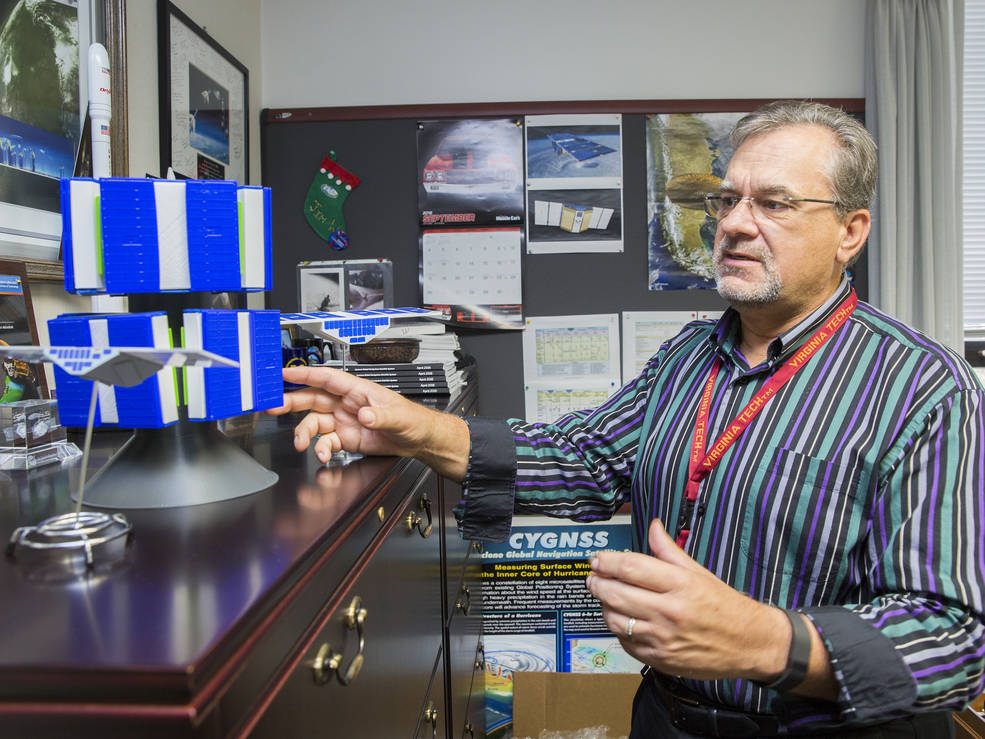

Technology has always progressed on waves of innovation. In the business of tropical system monitoring, a new set of satellites managed by NASA’s Langley Research Center in Hampton, Virginia, aims to ride a new wave of advanced weather prediction and storm tracking.
Previous space-borne instruments have been unable to accurately measure ocean surface winds in the inner core of hurricanes because their signals are degraded in regions of heavy precipitation. The Cyclone Global Navigation Satellite System (CYGNSS), a collection of eight low-cost, low-Earth orbiting microsatellite observatories that will travel to space on a single launch vehicle, is crafted to change that.
CYGNSS will measure surface winds in and near the inner core of tropical systems, including regions beneath the eyewall and intense inner rain-bands that could not previously be measured from space. The instrument will make the measurements using direct and reflecting signals from GPS satellites already in orbit.
“It’s all passive,” said Jim Wells, the NASA Langley mission manager of CYGNSS. “You don’t have to worry about active instruments, like a laser or radar. It’s all using existing GPS signals and technology but on a miniaturized scale.”
In orbit, each CYGNSS observatory will receive both direct and reflected signals from the GPS satellites. The direct signals will help pinpoint CYGNSS observatory positions, while the reflected signals respond to ocean surface roughness, from which wind speed is retrieved.
“We separate the observatories so that we can end up with all eight evenly spaced around the world,” he Wells said. “It’s a neat little concept.”
A single satellite can typically measure any location once every two or three days, but the eight CYGNSS micro-satellites will be able to capture measurements anywhere in the tropical oceans on average once every seven hours. That will help researchers see how tropical cyclones develop into hurricanes and better understand what causes the hard-to-predict variations in tropical system intensity.
The mission is slated for launch on Dec. 12, 2016, from Cape Canaveral Air Force Station in Florida, aboard an Orbital ATK Pegasus XL launch vehicle, with science operations beginning in the 2017 Atlantic hurricane season.
Potential impact
The ability to monitor and predict rapid changes in hurricane intensity is critical to hurricane forecasters, hydrologists and the emergency managers who together are responsible for the protection of the health and welfare of coastal communities.
CYGNSS is designed to remedy the inability of current remote sensors to see through the heavy rain in the inner core of a hurricane or to observe changes in the storm over short times, said Chris Ruf, CYGNSS principal investigator and director of the Space Physics Research Laboratory and an atmospheric, oceanic and space sciences professor at the University of Michigan in Ann Arbor.
“CYGNSS overcomes the first limitation by using a new type of remote sensing technique (GPS signal scattering) that can penetrate through heavy rain. It overcomes the second limitation by deploying a constellation of satellites all around the world, so any one place can be viewed much more often,” Ruf said.
Multifaceted involvement
CYGNSS is the first NASA Earth Venture mission in the NASA Earth System Science Pathfinder program.. The University of Michigan is responsible for directing all aspects of CYGNSS mission design and implementation, including the design of the constellation and production of retrieved surface wind speed estimates. The Science Operations Center for the mission is located at the University of Michigan.
“It’s incredibly rewarding to be able to help design and execute an entire mission, and to see all of the science and engineering pieces come together as we get closer and closer to launch,” Ruf said. “It’s gratifying to have our science goals be connected so closely to people’s everyday lives with better storm warnings.”
The Southwest Research Institute in San Antonio, Texas, is responsible for building and testing each of the eight CYGNSS microsatellite observatories, and is the host of the Mission Operations Center, located in Boulder, Colorado.
“It’s cool to think that we’ve done something that’s not been done before and you’ve worked with a lot of good people to do it because we really have a great team,” Wells said.
Ruf recognized NASA Langley’s involvement in the mission, as he recalled the university receiving help with modeling and analysis of some of the technical design details of the satellites. Also, Ruf said Wells helped “negotiate the many design and readiness reviews that were required, and was a great second set of eyes on many of our design and test decisions.”
Wells said when he was assigned the mission, he got excited the more he learned about the project.
“You’re paving new ground for ways to get things launched and ways to get new science,” he said.
Wells worked on satellites and shuttle payloads in his first years at NASA Langley. Since 1989, he has been a part of 15 missions, including the Cloud-Aerosol Lidar and Infrared Pathfinder Satellite Observation (CALIPSO), Lidar In-space Technology Experiment (LITE) and Sounding of the Atmosphere using Broadband Emission Radiometry (SABER), in various roles. Those missions were nothing like working on CYGNSS.
“It’s not cookie cutter,” he said. “It’s a one-of-a-kind, haven’t-been-done-yet deal.”
Gearing up for launch day
“It’s not often that you get a stacked deck like CYGNSS where you get to work with great people on a great mission,” Wells said. “I’ve learned over the years that those opportunities are rare. I really appreciate this one.”
Ruf said he can’t wait to get to the Mission Operations Center and start bringing the whole constellation of microsatellite observatories on line. “I’m sure there will be plenty of excitement at the launch itself, and then relief when we receive our first radio contact,” he said. “There’s a feeling of accomplishment that you’ve been a part of something that is bigger than you and that could have potentially have big impacts on a lot of people.”
[Source:-NASA]

